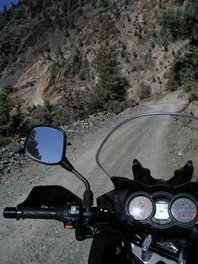"The villagers
understand my firing and changing their houses into bricks very easily,
and they relate to every part of it. But their hesitation as to what the
house may become has be be brought to the light. And for that I am
ready to freshen their memory with a walk to the old kiln just several
hundred steps away.
I ask the villagers if thee have been any kilns around here, the kilns to fire qanat kavals.
“Yes, right down the road,” says one.
“There, you can see it from here,” says the other.
The
kids start running that direction to show it to me. I don;t mention
what I intend to do, but ask my friends and the villagers to come
along. Everybody comes to see what I want to how. Ezzat, the eager
architectural student also jumps down from the roof and joins us with
his camera. The feeling is that there may be a puzzle I want to talk
about, or possibly refire the kiln or brick or something.
The several-hundred-step march is like an exodus from the village. To me it is an exodus from the present to the past.
We reach the kiln. Children climb all over the roof and the walls.
“What was this building used or before?” I ask the old man of the village aloud, while everyone I trying to guess.
It was a kaval kiln. In my childhood time I saw it fired.
“How long ago was that?” I ask.
“Oh, maybe 40 or 50 years ago, maybe even more. I don't know how old I am now. “ He laughs as he says hat.
I let them play around with the walls and touch the rock like pieces.
“They
used to fire it right from underneath on this big hole. They used to
burn wood, animal dung, or anything they could burn. Yes, see, right
around the firepit the soil is melted to rock,” the old man says while
while he tries to break a piece but can't. A younger man kicks a piece
with his boot; he can't break it either. Everyone laughs.
Then I stop them and ask them in a low voice, acing the old man and trying to have them observe silence.
“Amoo,
why have all your houses collapsed but this roo hasn't collapsed? Yet
you all plaster your roofs every year and you say that this roof is just
left under the rain and snow for thirty years?”
“Not thirty but fifty years,” he says.
“Okay, fifty years, Why is it still standing?” I ask.
A
middle-aged peasant answers in a loud voice from behind: “Don't you
understand? This is fired and baked to a rocklike brick. Even a
cannonball can't break it.”
Then there is a few seconds'
silence. Several have already made the connection. My architectural
students and engineer friends make the connection first, but before they
start to explain what I am trying to say, someone in the crowd says,
“So this is the puzzle?”
And in a few seconds everything falls in place.
The
history connects with the present. Moments link, and the chain is
completed. There is more silence, and everyone is digging a piece or
climbing to the roof. More conversation, more comments, and more
photographs, even several group portraits for the memory's sake are
taken on the roof. By the time we walk back, there seems to be no
question as to the validity of what we will be doing. And everyone
offers his house for the first firing."
Tuesday, January 19, 2021
A Reese's Peanut Butter Cups Moment
From
Nader Khalili's book _Racing Alone_, out of print, acquired at Berkeley
Public Library. It is a favourite reading moment of mine, and something
I have seen in several forms, beginning with the TV ad for Reese's
Peanut Butter Cups, where one complains that there is chocolate in his
peanut butter, and the other that there is peanut butter on his
chocolate.
Subscribe to:
Post Comments (Atom)

No comments:
Post a Comment